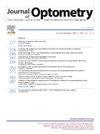Successful persistent strabismic amblyopia treatment using active therapy as an adjuvant to occlusion
IF 1.8
Q2 OPHTHALMOLOGY
引用次数: 0
Abstract
Purpose
A novel protocol to improve long-term results in the treatment of amblyopia was proposed. The protocol combines active home-based therapy through perceptual learning activities (Gabor patch, dichoptic stimulation, and random dot stereograms) with conventional visual therapy in the clinic as an adjunct to patching occlusion in subjects with patch-resistant amblyopia
Methods
Between 2018 and 2022, a group of patients received treatment for persistent strabismic and combined-mechanism amblyopia according to the novel treatment protocol, consisting of in-clinic orthoptics/visual therapy combined with the use of gamified PL software at home, as an adjunct to occlusion treatment.
Results
A retrospective analysis of treatment outcomes was subsequently carried out for 53 patients aged 7.75±5.88. Eccentric fixation was present in 17 of the 53 subjects.
The distribution of patients presenting with combined-mechanism and strabismic amblyopia was 37 and 16, respectively. Eighteen patients (34 %) demonstrated measurable stereoacuity prior to treatment. Following treatment using the combined treatment protocol, forty-six (87 %) participants achieved a of logMAR 0.1 or better, mean BCVA was significantly improved, from logMAR 0.30±0.23 to logMAR 0.07±0.12 (p < 0.01). Eleven subjects (65 %) of seventeen participants with eccentric fixation achieved central fixation. In addition, stereoacuity was measurable in 43 patients (81 %). Mean stereoacuity improved, from 1200.00±258.69 arc seconds to 539.62±518.69 arc seconds (p < 0.01). These results remained stable six months after completion of the therapy.
Conclusion
The outcomes of the proposed novel treatment protocol were reduced angle of deviation, and improved BCVA and stereoacuity in patients with persistent strabismic and combined-mechanism amblyopia.
成功的持续性斜视弱视治疗使用积极疗法作为辅助闭塞
目的提出一种改善弱视长期治疗效果的新方案。该方案结合了积极的家庭治疗,通过知觉学习活动(Gabor贴片,二分刺激和随机点立体图)与临床常规视觉治疗相结合,作为贴片抵抗性弱视患者贴片遮挡的辅助手段。在2018年至2022年期间,一组患者根据新的治疗方案接受了持续性斜视和联合机制弱视的治疗。包括临床矫视/视觉治疗结合在家中使用游戏化的PL软件,作为闭塞治疗的辅助手段。结果对53例患者(年龄7.75±5.88岁)的治疗结果进行回顾性分析。53例受试者中有17例出现偏心固定。合并机制弱视和斜视弱视分布分别为37例和16例。18名患者(34%)在治疗前表现出可测量的立体视力。采用联合治疗方案治疗后,46名(87%)参与者的logMAR达到0.1或更高,平均BCVA显著改善,从logMAR 0.30±0.23降至logMAR 0.07±0.12 (p <;0.01)。17名偏心固定的受试者中有11名(65%)实现了中心固定。此外,43例(81%)患者的立体视敏度可测量。平均立体视锐度从1200.00±258.69弧秒提高到539.62±518.69弧秒(p <;0.01)。这些结果在治疗结束6个月后保持稳定。结论提出的新治疗方案可降低持续性斜视和联合机制弱视患者的斜视角度,改善BCVA和立体视敏度。
本文章由计算机程序翻译,如有差异,请以英文原文为准。
求助全文
约1分钟内获得全文
求助全文

 求助内容:
求助内容: 应助结果提醒方式:
应助结果提醒方式:


